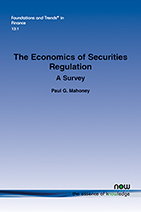The Economics of Securities Regulation: A Survey
By Paul G. Mahoney, University of Virginia School of Law, USA, pmahoney@law.virginia.edu
Abstract
This monograph reviews the academic literature that analyzes securities regulation from an economic perspective. It begins by describing the institutional foundations of securities law in the U.S. and distinguishing securities regulation from the private law of contracts, property, and fraud. Section 2 discusses the theoretical literature on mandatory versus voluntary disclosure in securities markets, focusing on information asymmetry and agency problems as justifications for mandatory disclosure. Section 3 surveys empirical work on the efficacy of actual mandatory disclosure rules. The remaining sections describe particular aspects of the U.S. regulatory system, including regulation of public offerings, publicly-traded companies, trading markets, securities fraud, insider trading, market manipulation, and mutual funds and other collective investment vehicles, and surveys important theoretical and empirical work on each. The monograph is intended to offer both institutional background and a summary of key research findings that may provide useful starting points for future research.
The Economics of Securities Regulation: A Survey
Securities markets are among the most heavily regulated sectors of the economy in developed nations. The Economics of Securities Regulation: A Survey gives an overview of the U.S. regulatory system, explores the justifications for regulating securities markets, and describes the qualitative and quantitative literature that assesses the regulatory system’s effectiveness. The monograph draws on the literature on the role of information in securities markets. Although detailed examples of regulatory provisions will be drawn from the U.S. securities laws, many of them have close analogues in other countries.
The Economics of Securities Regulation: A Survey focuses initially on mandatory disclosure, which is the most important feature of U.S. securities regulation. It then provides brief reviews of other specific regulatory categories, including regulation of public offerings, publicly-traded companies, trading markets, securities fraud, insider trading, market manipulation, and mutual funds and other collective investment vehicles. The monograph considers throughout whether the regulatory system can outperform litigation under the ordinary rules of property, contract, agency, and fraud, taking the costs of each system into account.
